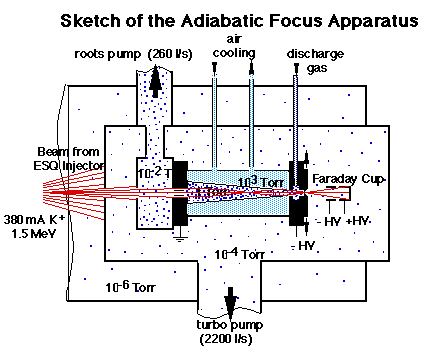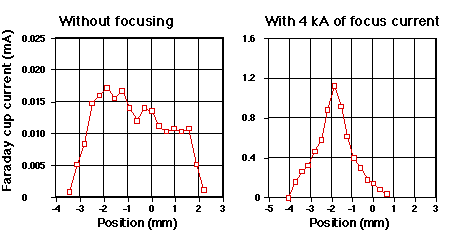Adiabatic Focusing of an Intense Ion Beam
Plasma lenses for heavy-ion beams have been developed and investigated for several years at the German Heavy Ion Laboratory GSI to concentrate high beam intensities onto small focal spots. The most promising results were achieved with a wall-stabilized discharge [1]. The typical beam energy for the GSI experiments was 11.4 MeV/amu. Discharge current and length of the lens were matched to produce less than half a betatron oscillation of the ions in the lens, that is the lens was used as a thin lens. The focus was formed a short distance downstream of the lens and detected by a combination of a plastic scintillator and a streak camera. A wall-stabilized discharge has proved to have better linearity of the focusing fields than a z-pinch discharge and provided the additional opportunity to taper the discharge tube and increase the focusing strength along the lens. Tests of a tapered discharge showed that a beam with 10 mm initial diameter can be focused to a spot of 0.16 mm [2].
For application of the plasma lens concept to the final focus problem in inertial confinement fusion the plasma lens must work as a thick lens, so that the particles perform one or more complete betatron oscillations inside the discharge. The particle trajectories in the lens are not necessarily coherent. The broader the momentum and charge state distribution in the beam, the more the trajectories deviate from the coherent case, and the more oscillations the particles perform in the lens. In the extreme case the beam fills the aperture homogeneously everywhere within the lens. Focusing can only be accomplished by increasing the focusing strength along the lens which can be easily achieved by tapering the discharge tube diameter. To avoid beam losses the tapering must be done adiabatically, which means that the change in betatron wavelength per betatron period must be small.
An experiment was designed to investigate this adiabatic focusing experimentally using the 2 MeV beam from the LBNL-ESQ injector. The schematic layout for this experiment is sketched in figure 2. The beam traverses a two stage differential pumping system that separates the discharge gas of approximately 1 Torr from the accelerator vacuum of 10 -6 Torr. The discharge tube radius is tapered from 10 mm to 2.5 mm to reduce the beam radius from 5 mm to 2.5 mm. The intensity distribution in the focused beam is scanned by a pinhole close to the end of the discharge and measured with a Faraday cup.

Sketch of the adiabatic focus apparatus mounted after
the injector matching section
An ion beam enters from the left and passes through three
apertures before entering the adiabatic-focus region. Only
10-15 mA of the original 380 mA potassium beam is admitted
to the focus region.
Experimental results indicate that pinch focusing increases the peak current density of the beam by a factor of more than 70. Without focusing the beam size is determined by the inner diameter of the tapered glass tube and little current is transported to the Faraday cup as shown on the left in figure below. With focusing the beam size is comparable to or smaller than the one millimeter movable pinhole in front of the Faraday cup, as shown on the right in the figure.

Current detected by a Faraday cup as a pinhole is
scanned across a beam
References
- [1] E. Boggasch, A. Tauschwitz, H. Wahl, K.-G. Dietrich, D.H.H. Hoffmann, W. Laux, M. Stetter, R. Tkotz, "Plasma lens fine focusing of heavy-ion beams", Appl. Phys. Lett. 60, 2475 (1992).
- [2] A. Tauschwitz, M. de Magistris, E. Boggasch, M. Dornik, D.H.H. Hoffmann, J. Jacoby, W. Seelig, P. Spiller, H. Wetzler, "Performance of a Shape Optimized Conical Plasma Lens", GSI Report 94-10, 10 (1994).
For comments or questions contact WMSharp@lbl.gov or DPGrote@lbl.gov. Work described here was supported by the Office of Fusion Energy at the US Department of Energy under contracts DE-AC03-76SF00098 and W-7405-ENG-48. This document was last revised June, 2002
